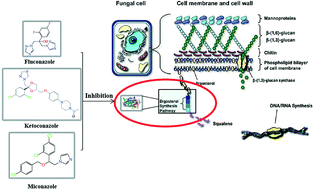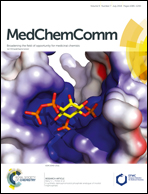Structure-based virtual screening and ADME/T-based prediction analysis for the discovery of novel antifungal CYP51 inhibitors
Abstract
With the increasing incidence of pathogenic fungi and drug-resistant fungi in clinic, it has become very important to develop the novel rate-limiting enzyme 14α-demethylase (CYP51) as an antifungal inhibitor. In this study, a method involving structure-based virtual screening was employed. First, a publicly available database was obtained from the Dow Chemical Company, and the database was screened by the designed pharmacophore model of CYP51 inhibitors. Then, the pharmacophore search hits were docked into the CYP51 crystal structure. Finally, sixteen compounds were selected for in vitro antifungal inhibition assay, and most of the compounds showed a certain degree of antifungal activity. In particular, compounds 3, 4, and 9 exhibited significant antifungal and anti-drug resistance activities by blocking the synthesis of ergosterol. The molecular docking and ADME/T properties of the compounds 3, 4, and 9 were further predicted, and the results indicated that they can form hydrophobic and coordination interactions with the active sites of CYP51. At the same time, compounds 4 and 9 showed promising drug-like properties. This study reveals that the compounds can be further optimized and developed as lead compounds.



 Please wait while we load your content...
Please wait while we load your content...